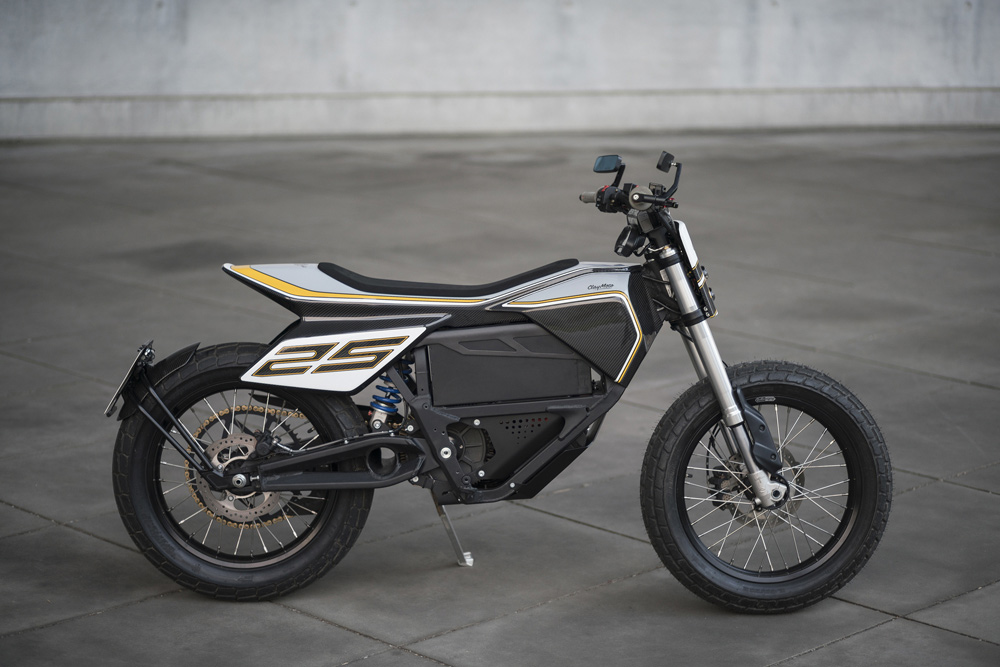- Client: Claymoto / Zero Motorcycles
- Our Role: Designer, Clay Modeller, Digital Modeller, Fabricator
This is a personal project that I built for myself, with the base bike a Zero FX, kindly provided by Zero Motorcycles.
Featured by Bike EXIF. Read the article here.
The idea for the “Quiet Riot” project came about back in the summer of 2017 when I was over in California working with Zero Motorcycles on the SR/F production model. At the time, the flat tracker movement was just gaining traction, and the FX seemed like an ideal base on which to build one. A relatively lightweight bike in Zero’s all-electric range that was crying out for a new style. Also boat loads of torque and the prospect of tuning the “engine braking” by means of altering the level of regen through the motor seemed like nice features for a flattracker.
Nothing really happened with the idea though until I returned to California in early 2018 for another project, and amazingly Zero gave me the green light and found me a bike to build on. So I then spent a load of evenings after work in the studio working on the clay.
The clay model took around 80 hours to complete. I only actually modelled half of the bike, as I typically use a mirror on the centreline to save me having to model both sides.
Working with a mirror is much faster, and allows me to see immediately how the clay looks in symmetry, so I can develop the form accordingly.
I took inspiration from the flat trackers of the 70s and early 80s, when flattrack was last a big thing. The large side and front numberboards being a staple feature of these bikes. Keeping the bike as smooth as possible around the knee area was also important so as not to catch the rider’s leathers when riding. I’ve always been an advocate of shrink wrapping the bodywork around the engineering package as much as possible, and this has been achieved here as much as possible.
After the model was finished, it was scanned, and the clay surfaces then rebuilt in Alias Autostudio – the industry standard digital modelling software. In Alias, all the surfaces are fine tuned to perfection, and from this data a full size ABS prototype was made to check the design fits perfectly on the frame. The next step was to then give the go ahead for the final moulds to be made to make the final carbon parts.
It sounds straight forwards, but the final production part too forever! Being a personal project, the budget has been rather tight, so getting the prototypes and moulds made in Europe was unfortunately not going to be an option. So the data was sent off to a firm in China in August 2018. When I excitedly received the parts 4 months later my heart sank. Although the carbon work was actually pretty nice, my finely tuned surfaces were all over the place with bumps and dents here and there. Clearly corners had been cut in making the main body piece mould. Ultimately I had to then make a jig to straighten out the part and resurface the whole thing by hand, before shipping it back to China for another mould to be made. To cut a long story short, I got the final versions of the bodywork 10 months later at the start of this summer. Yes, it was a long wait, but it was so worth it and the final parts are really good now, weighing in at just 2.4kg (5.3lb) for the complete set.
The base bike is a 2017 Zero FX with the 6.5 kWh battery pack.
Power 46 hp (34kW) @4300rpm
Torque – 78 ft.lb. (106Nm)
Range – You can thrash it for about 60km or take it easy for about 130km.
The main technical differences are:
• 2mm pre-preg carbon bodywork which fits directly onto the stock frame, (2.4kg (5.3lb) for the complete bodywork set.
• 19” SunRims laced to stock FX hubs with Shinko flattrack tyres.
• Slightly modified suspension front and rear (shortened stroke)
• The stock belt drive has been replaced with a chain and sprocket kit.
• There’s a 3mm thick aluminium bashplate and side plates.
• The rear lights, custom Cromoly numberplate hanger and mudguard are now mounted on the swingarm which can be easily removed in minutes as one unit.
• Headlights Shin Yo 50mm projector lamps. Tail lamp strip LED, and micro LED indicators all round.
• Rear brake on left handlebar – So much torque means the bike doesn’t need a gearbox, meaning there’s no clutch, which means you can relocate the rear brake lever up onto the left bar for better rear brake modulation while riding on circuit.
• Relocated speedometer to keep the clean tracker front number board look.

















